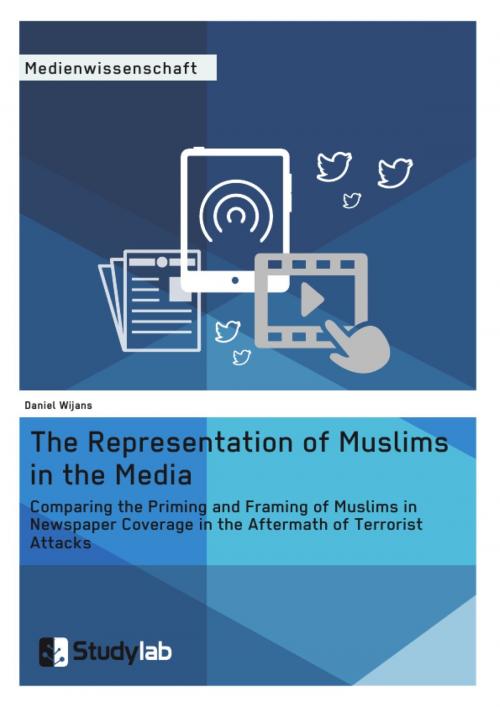The Representation of Muslims in the Media
Comparing the Priming and Framing of Muslims in Newspaper Coverage in the Aftermath of Terrorist Attacks
Nonfiction, Reference & Language, Language Arts, Journalism| Author: | Daniel Wijnans | ISBN: | 9783668202788 |
| Publisher: | Studylab | Publication: | April 22, 2016 |
| Imprint: | Studylab | Language: | English |
| Author: | Daniel Wijnans |
| ISBN: | 9783668202788 |
| Publisher: | Studylab |
| Publication: | April 22, 2016 |
| Imprint: | Studylab |
| Language: | English |
The Media can problematize, marginalize, exclude or sterotype social groups. This is often done by writing or speaking negatively about other social groups through text or talk. The purpose of this study is to linguistically examine the creation of a stereotyped image of Muslims through priming and framing in the media. Hence, this study explores if a stereotyped image of Muslims was identified in Dutch and British mainstream newspapers -De Volkskrant, Trouw, NRC, De Telegraaf, The Guardian, The Daily Mirror, The Daily Telegraph and the Sun- in the aftermath of the terrorist attack on Theo van Gogh in 2004, the 7/7 attacks in 2005 and the Charlie Hebdo attack 2015. In this way, this study is primarily occupied with; (1) if a stereotyped image of Muslims is created through language; (2) the agenda setting of Muslims; (3) the language used by journalists to describe Muslims in response to terrorist attacks at home or abroad. The analysis of language in the newspapers is conducted from a critical discourse analysis perspective and is done for both countries separately. The analysis of Dutch newspapers provides more evidence of stereotyped frames compared to the UK but there is not enough evidence to claim that any of the eight newspapers created a stereotyped image of Muslims in the aftermath of the studied terrorist attacks. Includes: - Priming Theory; - Agenda Setting Theory; - Framing Theory; - Critical Discourse Analytics; - Priming of Muslims in Newspapers; - Framing of Muslims in Newspapers
The Media can problematize, marginalize, exclude or sterotype social groups. This is often done by writing or speaking negatively about other social groups through text or talk. The purpose of this study is to linguistically examine the creation of a stereotyped image of Muslims through priming and framing in the media. Hence, this study explores if a stereotyped image of Muslims was identified in Dutch and British mainstream newspapers -De Volkskrant, Trouw, NRC, De Telegraaf, The Guardian, The Daily Mirror, The Daily Telegraph and the Sun- in the aftermath of the terrorist attack on Theo van Gogh in 2004, the 7/7 attacks in 2005 and the Charlie Hebdo attack 2015. In this way, this study is primarily occupied with; (1) if a stereotyped image of Muslims is created through language; (2) the agenda setting of Muslims; (3) the language used by journalists to describe Muslims in response to terrorist attacks at home or abroad. The analysis of language in the newspapers is conducted from a critical discourse analysis perspective and is done for both countries separately. The analysis of Dutch newspapers provides more evidence of stereotyped frames compared to the UK but there is not enough evidence to claim that any of the eight newspapers created a stereotyped image of Muslims in the aftermath of the studied terrorist attacks. Includes: - Priming Theory; - Agenda Setting Theory; - Framing Theory; - Critical Discourse Analytics; - Priming of Muslims in Newspapers; - Framing of Muslims in Newspapers















